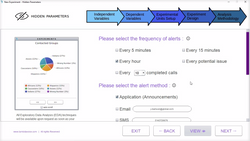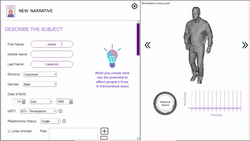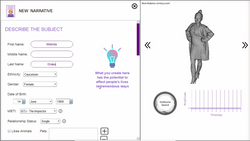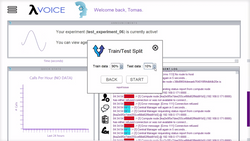
Platform Overview
The All-in-One Research Platform for
Speech and Conversation Dynamics
Studying speech and the social dynamics of conversations gives your organization an important edge for speaking with your audience.
LambdaVoice is designed as the all-in-one research platform that non-experts can easily use :
-
Design social Experiments.
-
Create highly expressive virtual agents to carry them out.
-
Deploy your Experiments and collect actionable insights to find out what works and what doesn't.
-
Inspect and analyze voices, sounds, behaviors, and much more.
1. Experiment Design
Through intuitive menu selections, users will become familiar with key terminology related to Experiment Design. Their experience as conversationalists is everything they need to get started.
Basic Terminology
-
Experimental Unit : Also referred to as EUs, the experimental units are the individuals or groups of people that the virtual agents will be speaking with throughout the experiment.
-
Independent Variable : Also referred to as IVs, the independent variables are things which are within the experimenter's control. Things such as the voice profile of the virtual agent (age, gender and ethnicity), the emotion control procedures (the way the agent responds emotionally to different stimulus), the agent's behaviors as decided by the experimenter (such as making compliments, referencing to a movie or pop culture, etc.)
-
Dependent Variable : Also referred to as DVs, the dependent variables consist of the set of observations made by the system during and after the call. Things like the pitch contour, the rhythm of speech, the responses to the agent's behavior and more.
-
Success Metric : Success metrics are determined by experimenters before the experiment begins. They are the key performance statistics that the Platform will use to grade experiments, success metrics include things like minimizing average call handle time, maximizing a survey's response rate, optimizing for customer emotional engagement, and more.
Platform default design: Factorial Experiments
A Factorial Experiment is one where the experimenter studies the effects of two or more factors on the target audience. A factor is an Independent Variable and it consists of two or more levels or variations of the IV. For example, the voice profile of a virtual agent is a factor which can take on many combinations of the ethnicity, gender and age of the underlying voice (e.g. "Caucasian Male 20s", "Hispanic Female 40s", "African Female 20s", etc.)
In the factorial design, every level of every factor is administered to every Experimental Unit at least once during the experiment.
 |  |
|---|---|
 |  |
 |  |
 |  |
 |  |
 |  |
 |  |
 |  |
 |  |
The LambdaVoice Experiment creation interface features a series of easy-to-fill forms with suggestions and step-by-step explanations for users.
Choosing special behaviors, defining experimental units, or establishing success metrics is quick and easy to learn.
2. The Narrative System
In order to engage in meaningful conversations, Virtual Agents need to be coherent. The way in which users can ensure their Agent's language models don't accidentally generate speech that is either incoherent or inconsistent with your organization's values is by creating a character Narrative.
Emotive Speech Synthesis and the Myers-Briggs Type Indicator
Also known as the Myers-Briggs Personality Types Index, or MBTI for short, this introspective self assessment questionnaire used to be promoted as an indicator of one's personality type. The test assigns one of sixteen personality types to the person taking it based on four pairs of preferences, or dichotomies, as they manifest themselves in the answers from the questionnaire.
Although it was loosely inspired from the Personality Theory of 20th Century leading clinical psychologist Carl Gustav Jung, the MBTI is widely criticized by academic researchers and we do not believe it to be an adequate indicator of human personality traits.
Instead, we use it on the platform to streamline the classification of general behavioral tendencies when users create Virtual Agents :
-
The user defines general characteristics of the Narrative (name, gender, ethnicity, date and place of birth, parents, siblings, personal interests, etc.)
-
The user assigns one of the sixteen personality types which will influence the Agent's emotional response (emotive speech synthesis) to different events :
1) The Architect - INTJ 2) The Logician - INTP
3) The Commander - ENTJ 4) The Debater - ENTP
5) The Advocate - INFJ 6) The Mediator - INFP
7) The Protagonist - ENFJ 8) The Campaigner - ENFP
9) The Logistician - ISTJ 10) The Defender - ISFJ
11) The Executive - ESTJ 12) The Consul - ESFJ
13) The Virtuoso - ISTP 14) The Adventurer - ISFP
15) The Entrepreneur - ESTP 16) The Entertainer - ESFP
Note: The use of MBTI here is similar to character classes in Role-Playing Games, adding to the gamification of the traditional contact center day-to-day.
When creating Agents on LambdaVoice, users are able to use their past experiences as conversationalists to imagine intricate life stories. An exercise which will prove to be fun and engaging.
 |  |
|---|---|
 |  |
 |  |
3. Conversation Simulator
The backbone of the LambdaVoice Virtual Agent system is the Conversation Simulator application. It uses five powerful neural network modules for tasks such as multi-level sentiment analysis, dependency parsing and text compression to build a model of what the requested conversation looks like. It also makes minimal use of a large language model (LLM) but the underlying objective being to offer large scale deployment, this module is only used for generating small parts of the conversation.
Users need only describe the type of conversation and the parameters of the experiment in order to simulate large quantities of conversations over a short period of time (generally under an hour for several thousand samples).
Here's how it works :

Once the simulations are complete, users have a chance to analyze the results using the Script Viewer to make sure the Agent does in fact behave as intended.
This provides users with fine-grained control over the conversation flow.
4. Conversational Models
Virtual Agents on LambdaVoice operate using a stack of neural network modules, with each module handling the logic of a separate conversation segment. These modules are trained under the supervised learning paradigm, using the dataset produced in the Conversation Simulator.
Users aren't required to have any understanding of Machine Learning or optimization algorithms, the Platform automates the setup of hyper-parameters and optimization.
The Platform Design assumes no prior knowledge but offers optional training and support documentation.
 |  |
|---|---|
 |  |
 |  |
5. Deployment
LambdaVoice works as a large-scale distributed system, each Agent system runs on a dedicated server and the cluster of Virtual Agents is managed by a Central Manager. Once users have designed their experiments and created Virtual Agents, they can easily assign and deploy them for real calls. The Central Manager enables your team to control the collection and leveraging of conversational data.
 |  |
|---|---|
 |  |
 |  |
 |
The Agent Server Hub features an easy-to-use 3D grid system enabling users to get an overview of server activity in real time.
We offer a high-performance cloud compute solution for organizations who wish to rent servers instead of buying and maintaining them.
Multi-Channel Communication
Conversational Models are deployed in a real-time, voice-driven environment through the following channels:
-
Traditional telephone line
-
SIP trunk solution
-
Full-duplex UDP
(*) LambdaVoice also offers limited web-integration solutions for Facebook Chat, Twitter, and Email. Please note that in the web-integration scenario, only text-related feedback such as sentiment analysis and keyword tracking is available.
6. Results Analysis
The Central Manager's scheduling system automatically commissions and decommissions Agent servers according to their scheduled work shifts. Leads can either be provided by users directly or the system can generate phone numbers, cross-referencing with previously contacted individuals (please note that if operating in Canada, you must be registered with the CRTC's Do-Not-Call List before attempting to call the public).
Users can track real-time statistics about their experiment in the Experiment Overview
 |  |
|---|
 |  |
|---|---|
 |  |
The Agent Statistics interface provides useful information like cross-task performance, how the agent performs with different ethnic groups or male/female customers.
3D Voice Map: An Analytical Tool
In order to analyze voices to gain insight into how they relate to one another, LambdaVoice uses a neural network which was trained to produce a high dimensional vector space in which every speech sample is embedded. The neural network was trained to produce these embeddings by constructing clusters of similar-sounding voices by making sure that the centroid of each speaker cluster was as far as possible from the centroids of other speaker clusters.
Contact
Like what you see? Get in touch to learn more.